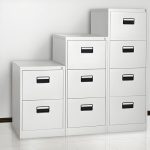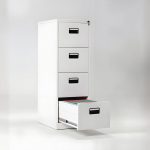When it comes to furnishing a home or office, cabinets are essential for storage. However, not all cabinets are the same, especially when it comes to their assembly process. Various types of cabinets are available in the market, each with a unique structure and assembly requirements. The terms can be confusing: Knock-Down (KD), Ready-to-Assemble (RTA), Pre-Assembled, and Fully Assembled.
What do these terms mean, and more importantly, which one is the right choice for you? This guide will break down the pros, cons, and ideal scenarios for each option to help you make an informed decision.
Understanding Different Types of Cabinets
1. Knock-Down (KD) Cabinets
What are they? Knock Down Cabinets, often referred to as KD cabinets, is the term used in the industry for cabinets that are built in a factory but shipped to your home (or to a dealer) unassembled. "Knock-down" means they are meticulously crafted and then taken apart for shipping.
- Assembly Required: Significant. You or your contractor will need to assemble the boxes, install the doors, drawers, and hardware. It requires skill and tools.
- Pros:
- Highest Quality: Often considered the premium option, allowing for custom sizes and finishes.
- Easier Delivery: Disassembled boxes can be maneuvered through narrow hallways and stairs more easily than large, assembled units.
- Customization: Typically sold through kitchen designers and dealers, offering a wide range of customization.
- Cons:
- Requires Professional Installation: Not a DIY project for most people. You will likely need to hire a skilled carpenter or installer.
- Higher Cost: The combination of high-quality materials and professional labor makes this the most expensive option.
- Best For: Homeowners undertaking a high-end, custom kitchen renovation with a professional contractor handling the installation.
2. Ready-to-Assemble (RTA) Cabinets
RTA cabinets are the quintessential DIY flat-pack boxes you find from online retailers and big-box stores like IKEA or Home Depot. These cabinets get designed from the ground up for shipping and assembly by the consumer.
- Assembly Required: Extensive. You will build every single cabinet from the ground up using cam locks, screws, and dowels included in the package.
- Pros:
- Cost-Effective: This is the biggest advantage. You save a significant amount of money by eliminating assembly and labor costs.
- DIY-Friendly: Designed for self-assembly with detailed instructions (usually with pictures).
- Convenient Shipping: Flat boxes are easy to ship and store until you're ready to assemble.
- Cons:
- Time-Consuming: Assembling a full kitchen's worth of cabinets can take a very long time.
- Skill Dependent: The final result depends entirely on your assembly skills. Mistakes can lead to wobbly or misaligned cabinets.
- Material Quality Varies: Often made from particleboard or MDF (though many offer upgraded finishes and durable hardware).
- Best For: Budget-conscious DIYers who are handy, patient, and want a new look without the cost of professional installation.
3. Pre-Assembled (or Semi-Assembled) Cabinets
What are they? This is a fantastic middle ground. The main cabinet "box" comes fully constructed. You typically only need to attach the doors, drawers, and hardware. Many cabinet lines at home improvement stores fall into this category.
- Assembly Required: Minimal. It's mostly about attaching the final components.
- Pros:
- Time-Saving: Drastically reduces the assembly time compared to RTA.
- Good Stability: The core structure is built professionally in a factory, ensuring a square and sturdy box.
- Easier for DIYers: Much harder to mess up the core construction. Great for those with moderate DIY skills.
- Cons:
- Less Customizable: Usually come in standard sizes with limited modification options.
- Bulkier to Transport: The assembled boxes are larger than flat-packs, but still manageable.
- Best For: DIY homeowners who want a balance between quality, ease of installation, and cost. Perfect for those who find RTA too daunting but don't want to pay for full custom.
4. Fully Assembled Cabinets
What are they? As the name implies, these cabinets come completely put together. Doors are hung, drawers are inserted, and hardware is attached. They are delivered ready to be installed directly onto your wall.
- Assembly Required: None. Only installation is required (securing the cabinet to the wall and to adjacent cabinets).
- Pros:
- Ultimate Convenience: Unbox them, position them, and screw them in. It's the fastest and simplest installation process.
- Professional Finish: You can immediately see and feel the quality and finish without any risk of assembly errors.
- Ideal for Refacing: Perfect if you're replacing old cabinets but keeping the same layout.
- Cons:
- Most Expensive Upfront Cost: You pay for the factory labor.
- Logistical Challenges: Large, assembled cabinets can be very difficult to maneuver through doorways, around corners, and down stairs. This is a critical consideration for older homes with narrow passages.
- Best For: Homeowners who want a hassle-free experience and are willing to pay for it, especially in homes with straightforward layouts that can accommodate large objects. Often chosen for quick kitchen updates.
Overall Comparison
Structural Similarity: They all belong to the "cabinet" furniture category. The basic functional unit is a box-like structure, made up of elements such as doors, side panels, base panels, back panels, and internal shelves.
Core Difference: The primary difference lies in the "state of assembly upon delivery" and the "production process and materials used."
- Knock Down (KD) cabinets and Ready-To-Assemble (RTA) cabinets are essentially the same concept, referring to flat-pack cabinets that require user assembly.
- Pre-assembled cabinets and fully assembled cabinets refer to cabinets that have already undergone full or partial assembly at the factory. However, "Pre-assembled" generally refers to kitchen cabinets, while "Fully assembled" is a broader term.
Summary of Differences
| Feature | Knock Down (KD) Cabinets | Ready-To-Assemble (RTA) Cabinets | Pre-assembled Cabinets | Fully Assembled Cabinets |
|---|---|---|---|---|
| Chinese Reference | Disassembled Cabinets | Ready-to-Assemble Cabinets | Pre-assembled Cabinets | Fully Assembled File Cabinets/Cabinets |
| State of Delivery | Unassembled (Flat-pack) | Unassembled (Flat-pack) | Partially Assembled (Carcass complete) | Fully Assembled (Finished product) |
| Assembly Required? | Yes | Yes | Minimal (Professional installation) | No |
| Primary Users | DIY users, Budget-conscious consumers | DIY users, Budget-conscious consumers | Professional renovators, Homeowners | Corporate procurement, Quality-seeking users |
| Price Level | Low | Low | Medium to High | High |
| Shipping Cost | Low | Low | Medium | Very High |
| Primary Application | General furniture | General furniture | Kitchen and bathroom cabinets | Office furniture, High-end household use |
Your Decision Checklist: How to Choose
Ask yourself these questions to find your perfect fit:
My budget?
- Tight Budget: RTA is your champion.
- Moderate Budget: Pre-Assembled offers great value.
- Healthy Budget: KD (for custom) or Fully Assembled (for convenience).
What is my skill level and how much time do I have?
- Skilled & Patient DIYer: RTA or Pre-Assembled.
- Not Skilled or Short on Time: Pre-Assembled or Fully Assembled.
- Hiring a Pro: KD or Fully Assembled.
What are the logistics of my home?
- Narrow hallways, tight corners, or stairs? KD or RTA (flat-pack) is the safest bet.
- Open, straight path to the kitchen? Fully Assembled or Pre-Assembled are viable options.
How custom does my space need to be?
- Standard Layout: Pre-Assembled or RTA from a big-box store.
- Unique, Non-Standard Layout: Knock-Down (custom order) is the way to go.
There isn't a single "best" type of cabinet—only the one that fits your project, skills, budget, and timeline. By understanding the differences between Knock-Down, Ready-to-Assemble, Pre-Assembled, and Fully Assembled, you can choose the cabinets that will bring your vision to life without any surprises.





